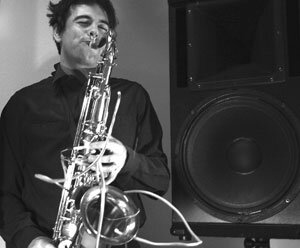CULTURE- BUZZBOX- Noise makers: Technosonics trade fugues for racket
It's only February, but we're prepared to place our bets already: chances are the Technosonics Festival at Live Arts on Monday, February 12, will be one of the most challenging, forward-thinking musical events Charlottesville will see in 2007.
It's not exactly a tough thing to predict, since that's exactly what it's been in years past; Technosonics is now in its seventh year as the flagship presentation of the nuttier side of the UVA Music Department and the professors who are prone to trading fugues and sonatas for oscillating whatchamadoodles. This year's iteration focuses on noise.
"In acoustic noise, all frequencies are present at equal amplitude," explains professor Matthew Burtner. "What's really beautiful is that it's the opposite of silence– which is all frequencies at zero amplitude. It's like a block of stone you can carve out of."
Burtner and fellow professor Ted Coffey are two of the department's expert whatchamadoodlers, and each has a different take on this year's theme.
"The work that I'm including in the show is called 'Wind Sketches,' and it draws on ecological noises," says Burtner. "A lot of the sounds we love as people and are comfortable with– the ocean, the wind– have a high degree of acoustic noise."
The piece also features Burtner playing an instrument he created himself, a turbocharged sax with acoustic, electric, and computerized functions he calls the Metasaxophone.
Coffey, on the other hand, uses more conventional tools, but to equally unconventional ends: "I have a lot of environmental recordings, and a lot of recordings of nothing. I just use various signal chains and then crank the volume, so you hear the coloration that the technology introduces," he says. "It's like room noise, except sometimes I'm running it through a distortion pedal."
It's about more than just sound, though; they claim the compositional approach is just as important.
"In a piece of music, some things are stable, and some things are composable parameters," explains Coffey. "Typically instrumentation is stable, and pitch is a composable parameter. In my music, production value is a composable parameter. I go from a very lo-fi garage band sound to extremely slick computer music sound. They're put together in a way that's like a collage."
Both are excited about moving the event away from its former home at Old Cabell Hall. They hope that a downtown presentation will attract listeners who might not ordinarily have paid attention.
"We're at a time now where there is more of a conversation between people doing things for the market and people who are supported by institutions. We're using a lot of the same tools to make our music," says Coffey. "I think this program is an example of that openness."
"I listen to Radiohead in addition to Ligeti," he adds.
In fact, the title track from the larger-than-life band's groundbreaking "Kid A" samples the first computer music piece composed by Princeton whatchamadoodler Paul Lansky. Coffey sees the work of Aphex Twin and the Intelligence Dance Music scene as similar convergences.
"That stuff might not make it into some squarish American electronic music conference," he says,."I personally would prefer one large community to a lot of splintered communities."
Burtner realizes that Technosonics might be a lot to wrap a punk rock head around, but he insists that's not a problem – in fact, that's the whole point.
"It's perfectly normal not to know what this music is," he says. "One of the exciting things about being a viewer of contemporary art and culture is that you get to actively sort through it." So he suggests that listeners shouldn't hesitate to be judgmental. "Just don't expect it to have a beat," he warns.
In trying to open the world of experimental electronic music, Coffey looks with great amusement to the work of Emory doodler Steve Everett, who spent some time looking at audiences at new music concerts only to realize that they were all concerned about what to wear to such a hip, intellectual, and yet somehow fundamentally rock-and-roll event.
"The answer," says Coffey wryly, "is jeans."
Technosonics VII Festival: NOISE, an evening of performed electronic and computer music, at Live Arts Monday, February 12. Free, 8pm. Refreshments served.

Matthew Burtner
Publicity photo
#